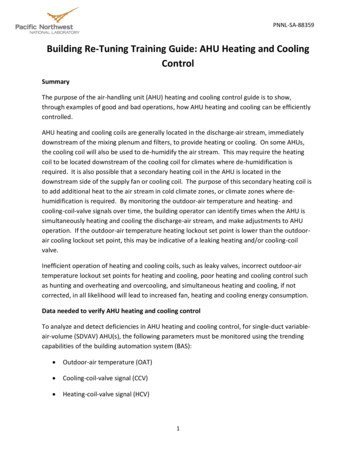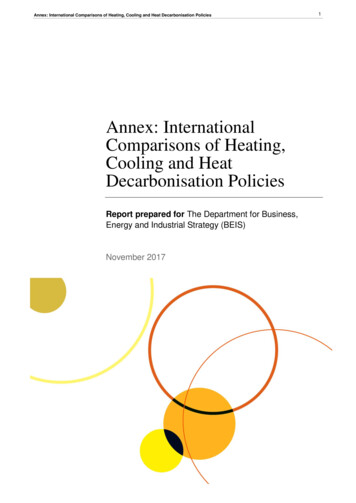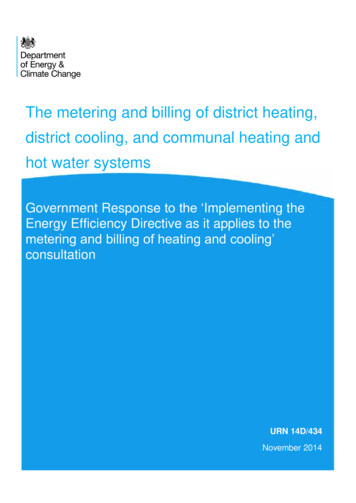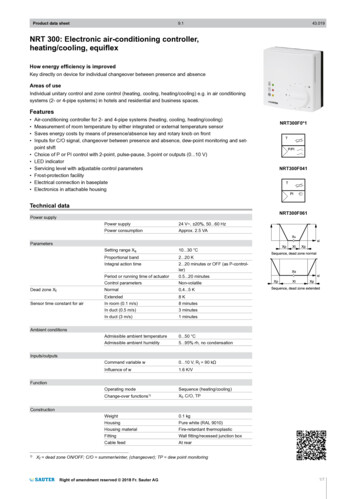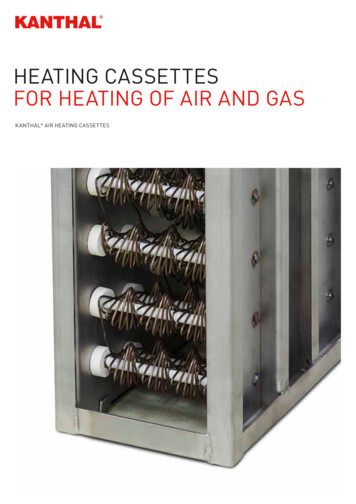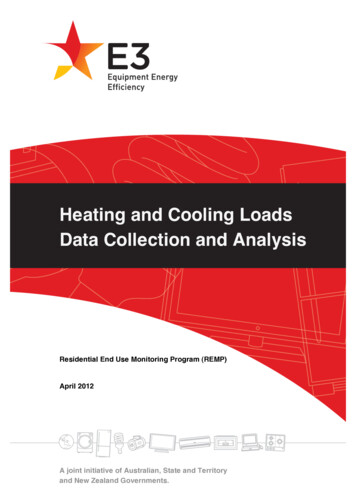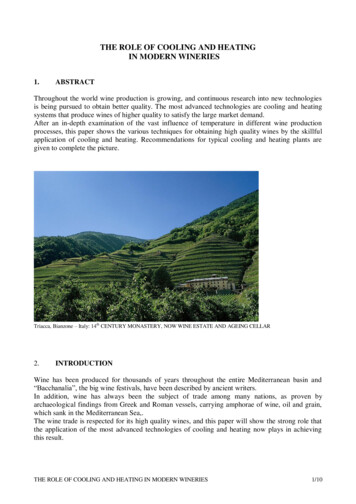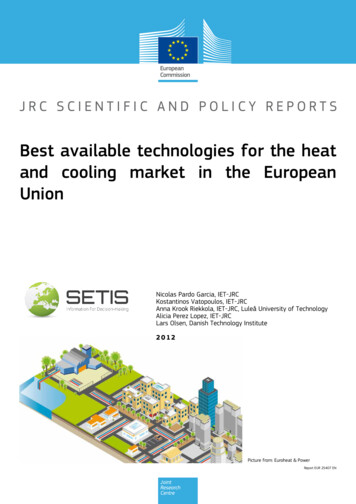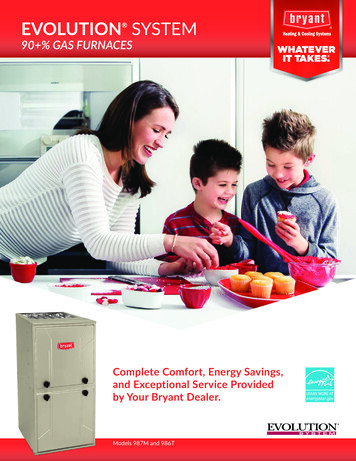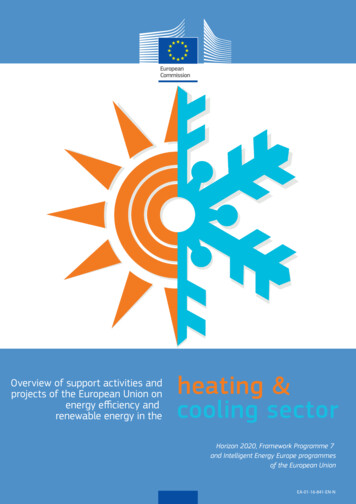
Transcription
Overview of support activities andprojects of the European Union onenergy efficiency andrenewable energy in theheating &cooling sectorHorizon 2020, Framework Programme 7and Intelligent Energy Europe programmesof the European UnionEA-01-16-841-EN-N
EUROPEAN COMMISSIONThis publication has been drafted with contributions from the Executive Agency for Small andMedium Enterprise (EASME), the Innovation and Networks Executive Agency (INEA), theDirectorate General for Energy (DG ENERGY) and the Directorate General for Research andInnovation (DG RTD).For further information on this publicationyou can contact EASME-Energy@ec.europa.euLEGAL NOTICEThis document has been prepared for the EuropeanCommission however it reflects the views only ofthe authors, and the Commission cannot be heldresponsible for any use which may be made of theinformation contained therein.More information on the European Union isavailable on the Internet (http://www.europa.eu)Cover image Matthew Hertel iStock.comLuxembourg: Publications Office of the European Union, 2016 European Union, 2016Reproduction is authorised provided the source is acknowledged.ISBN -N
EXECUTIVE SUMMARYWhat is thesupporting?Europeannumber of projects are currently beingsupported in the heating and cooling sector.UnionHeating and cooling consume half of the EU’senergy and much of it is wasted. The lion'sshare of heating and cooling is still generatedfrom fossil fuels, mainly natural gas, whileonly 18% is generated from renewableenergy. In order to fulfil the EU’s climate andenergy goals, the heating and cooling sectormust therefore sharply reduce its energyconsumption and cut its use of fossil fuels. Tothis end the European Commission adopted aheating and cooling strategy in February2016 as part of the wider Energy UnionPackage. A number of activities and projectsfunded by the programmes of EuropeanUnion are supporting this new EU heating andcooling strategy.This document provides an overview of theEU-funded projects in the area ofheating and cooling. It focuses on theHorizon 2020 programme for research andinnovation (2014-2020) and its predecessors:the former Seventh Framework (FP7) andIntelligent Energy Europe (IEE) programmes.For practical reasons, the scope of theprogrammes has been limited to thefollowing: Horizon 2020 Calls 2014-2015,FP7 Smart Cities Calls 2012 to 2013 and theIEE Calls 2011 to 2013.Actions supported by these on of energy efficient andrenewable heating and cooling solutions.Supportisalsoprovidedforthedemonstration of innovative approaches andfor the integration of sustainable heatingand cooling infrastructure in EU cities.Via market uptake actions, support is beingprovidedtoovercomethenontechnological barriers hindering theuptakeofenergyefficiencyandrenewable heating and cooling solutions.Finally public and private bodies are beingsupported in developing bankable d by dedicated technical assistancefacilities. A number of these projects aim atlaunching investments for large scale heatingand cooling infrastructure including districtenergy projects using local low carbon andrenewable energy sources.The dedicated SME instrument of Horizon2020 supports close-to-market activities,with the aim to give a strong boost tobreakthrough innovation. Highly innovativeSMEs with a clear commercial ambition and apotentialforhighgrowthandinternationalisation are the prime target. AIn addition to the activities above mentionedthe EC is also managing a number of tendersin support of the Heating and Cooling sectorincluding a study on the current and future(20202030)heating/coolingfueldeployment. Besides, the EC is providingsupport to the key activities of the EuropeanTechnology Platform on RenewableHeating and Cooling.Overall funding figuresAs shown in this report, present day supportto heating and cooling from the EuropeanUnion's research and innovation programmesis significant. A total of circa EUR 166million of EU funding is allocated toresearch, demonstration and marketuptake of energy efficient, low carbonand renewables heating and coolingsolutions. A breakdown is provided in thetable below.Why heating and cooling?With 50% of final energy consumption in2012 (546 Mtoe) heating and coolingaccounts the EU's biggest energy use andit is expected to remain so. The Commissionheating and cooling strategy makes clearlythe case that demand reduction and thedeployment of renewable energy and othersustainable sources, such as waste heat,have a great potential to reduce fossil fuelimport and ensure energy supply security,while ensuring affordable provision of energyfor the end consumer. 45% of energy inheating and cooling in the EU is used in theresidential sector, 36% in industry and 18%in services. Each of these sectors has thepotential to reduce demand, increaseefficiencyand shift to renewable sources.Bearing in mind that 75% of the fuel thissector uses still comes from fossil sources,the decarbonisation of the heating andcooling sector is essential to reach the energyand climate change objectives. It is howevera fragmented sector, characterised by anageing and inefficient building and appliancestock and with a high unused potential inindustry.More research and innovation is requiredto further improve and develop technologiesand solutions that allow exploiting the fullpotential of low carbon and renewable energysources for heating and cooling. There isalreadyawiderangeofproventechnologies and solutions available onthe market although more is needed toincrease their market share. Against thisbackground, the programmes of the EU cometo provide direct support to the objectives of
the heating and cooling strategy supportingactions in the following areas:i.ii.Research and development of new andimproved heating and cooling supplytechnologies using renewable energysources for applications in buildings andindustry.Research and development of innovativeconcepts, as well as of improved controls,for district heating and cooling networksto maximise the uptake of residual andrenewable sources of thermal energy.iii.Development of integrated solutions ofthermal energy storage for applications inthe building sector.iv.Research and development of heatrecovery solutions in industrial processes.v.Demonstration of innovativerelated to smart grids.vi.Support to the acceleration in the marketof proven and mature energy efficiencyand renewable heating and oling underFP7, IEE andHorizon 2020programmesType of ActionEU fundingResearch and Innovation (H2020 2014-2015 Energy Efficiency)EUR 40.1 millionResearch and Innovation (H2020 2014-2015 Low CarbonEnergy/Renewables)Innovation (H2020 2014-2015 Low Carbon Energy/Renewables)EUR 29.3 millionSmart Cities (FP7 Call 2012,2013)EUR 41.6 million1Market uptake (IEE Calls 2012,2013, H2020 2014,2015 Energy Efficiency)EUR 15.6 millionMarket uptake (H2020 2014-2015EUR 5.3 millionLow Carbon Energy/Renewables)EUR 18.3 millionTechnical assistance and innovative financing (IEE Calls 2011-2013, H20202014,2015)SME Instrument (H2020 2014-2015 Phase 1 and 2)EUR 5.6 millionTotal*EUR 166.1 millionSmart Cities and Communities (H2020 Calls 2014-2015)EUR 174.1 millionEUR 10.3 millionSummary of EC funding in the area of heating and cooling including the following: Horizon 2020Calls 2014/2015, Smart Cities FP7 Calls 2012/2013, IEE Calls 2011/2012/2013. * Note that thetotal excludes the Horizon 2020 Smart Cities and Communities Calls 2014, 2015 as only a fractionof the activities are related to heating and cooling.1This includes FP7 Smart Cities Call 2012 on H&C and the main H&C related project from the 2013 SCC call. Additional funding ofEUR 174.1 million has been allocated to Smart Cities Call of Horizon 2020 2014-2015. A fraction of the activities supported hereincludes support to heating and cooling.
Supporting sustainable heating and cooling in IEE, FP7, and Horizon 2020Research &InnovationInnovation &Demonstration(FP7, Horizon 2020)(FP7, Horizon 2020)District heating and coolingoptimisationEnergy efficient and renewableenergy sourced heating andcooling technologies.Innovative integration of sustainableheating and cooling infrastructureat district and city levelsEnergy efficient and renewableenergy sourced heating and coolingtechnologies.Market uptake(IEE, Horizon 2020)Policy support to national, regionaland local authorities, heating andcooling planning, capacity buildingfor market actors, training forinstallers, quality labelling ofproducts, market analyses,streamlining of administrative andauthorisation procedures, etc.SME instrumentTechnical assistance(IEE and Horizon 2020 ProjectDevelopment Assistance)Support to public and private actors forlaunching large scale investment forenergy efficiency in buildings andsustainable H/C infrastructureSupport includes feasibility studies,stakeholder and communitymobilisation, financial engineering,business plans, technical specifications,procurement procedures, etc.Technical assistance facilities includePDA support under the EnergyEfficiency part of the Horizon 2020Energy Challenge and the EuropeanLocal ENergy Assistance (ELENA)Areas of support of the European Union on energy efficiency and renewable energy in the heating and cooling sector (scope: IEE, FP7 and H2020 programmes).Support for heating and cooling also exists under the LIFE programme and under the European Structural and Investment funds. The European Fund for StrategicInvestments (EFSI) could also be used to support heating and cooling infrastructure projects. EFSI is an initiative launched jointly by the European InvestmentBank Group and the European Commission is designed to help overcome the current investment gap in the EU by mobilising private financing for strategicinvestments.
TABLE OF CONTENTSEXECUTIVE SUMMARY . 1TABLE OF CONTENTS . 41.SUPPORT TO RESEARCH, INNOVATION AND DEMONSTRATION . 61.1 SUPPORT TO LOW CARBON ENERGY HEATING AND COOLING . 61.2 SUPPORT TO ENERGY EFFICIENT HEATING AND COOLING SOLUTIONS . 7District heating . 7Technology for buildings and districts . 8Waste heat recovery in industry. 92.SMART CITIES AND COMMUNITIES . 143.SUPPORT TO MARKET UPTAKE ACTIVITIES . 183.1 SUPPORTING HEATING AND COOLING PLANNING . 18Implementation of the Energy Efficiency Directive . 18Supporting National Authorities . 18A Pan European Thermal Atlas . 183.2 PROMOTING DISTRICT HEATING AND COOLING SYSTEMS . 193.3 CAPACITY BUILDING IN REGIONS . 193.4 REMOVING ADMINISTRATIVE AND FINANCIAL BARRIERS . 19Streamlining of administrative and authorisation procedures . 19New business models . 203.5SUPPORTING DECISION MAKING: EMPOWERING CONSUMERS AND ENERGYLABELLING . 20Empowering end-consumers to take informed decisions . 20Energy labelling directive covering heating products . 214.TECHNICAL ASSISTANCE AND INNOVATIVE FINANCING FOR HEATING AND COOLING . 245.SME INSTRUMENT. 256.OTHER STUDIES . 29ANNEX 1 – RESEARCH AND INNOVATION – ENERGY EFFICIENCY: PROJECT FACTSHEETS . 30STORM technology for DHC . 31OPTi technology for DHC . 32FLEXYNETS technology for DHC . 33INDIGO technology for DHC . 34E2DISTRICT technology for DHC . 35H-Disnet technology for DHC . 36InDeal technology for DHC . 37TASIO waste heat recovery in industrial processes . 38SusPIRE Waste heat recovery in industrial processes . 39iTherm waste heat recovery in industrial processes . 40Indus3Es waste heat recovery in industrial processes . 41ANNEX 2 – RESEARCH AND INNOVATION – ENERGY EFFICIENCY IN BUILDINGS: PROJECTFACTSHEETS . 42CREATE technology for thermal Storage for EeB . 43TESSe2b technology for thermal Storage for EeB . 44ANNEX 3 – RESEARCH AND INNOVATION – LOW CARBON ENERGY: PROJECT FACTSHEETS . 45FlexiFuel-SOFC micro combined heat and power . 46
Bio-HyPP combined hybrid heat and power . 47Residue2Heat Residential Heating fuelled by FPBO . 48CHPM2030 Combined Heat, Power and Metal extraction . 49FlexiFuel-CHX Low Emission Condensation Residential Heating fuelled by solid biomass 50SOLPART High Temperature Solar-Heated Reactors for Industrial Processes . 51ANNEX 4 - INNOVATION / DEMONSTRATION – LOW CARBON ENERGY: PROJECTFACTSHEETS . 52Cheap GSHPs drilling/installation for shallow geothermal . 53GEOTeCH drilling concept for geothermal . 54ORC-PLUS Thermal Sotorage, CSP and ORC . 55ANNEX 5 – SMART CITIES AND COMMUNITIES: PROJECT FACTSHEETS . 56GrowSmarter Demonstration of integrated smart solutions . 57Triangulum Integrated infrastructures and sustainable mobility . 58Remourban Sustainable urban regeneration . 59CELSIUS Smart DHC demonstrators . 60PITAGORAS Industrial waste heat recovery to DH demonstrator . 61READY Smart City demonstrator . 62REPLICATE Smart city technologies in energy, transport and ICT . 63SMARTER TOGETHER Smart technologies and governance dimensions . 64SmartEnCity Integrated planning and implementation . 65SHAR-LLM Agile and collaborative smart city market . 66ANNEX 6- MARKET UPTAKE – ENERGY EFFICIENCY AND LOW CARBON ENERGY: PROJECTFACTSHEETS . 67LabelPackAPlus energy labelling . 68progRESsHEAT heating and cooling planning . 69SDHp2m Policies for solar district heating . 70CoolHeating Modular district heating grids. 71Bioenergy4Business heat from biomass . 72SuperSmart energy labelling in supermarkets . 73HRE heating and cooling planning . 74STRATEGO heating and cooling planning . 75RES H/C SPREAD heating and cooling planning . 76SmartReflex planning and implementation of RES DHC . 77FRONT support schemes and end user support on RES H/C . 78SDHPLUS solar thermal district heating . 80GEODH geothermal district heating . 81RESCUE smart district cooling . 82BIOGAS HEAT heat from biogas . 83REGEOCITIES shallow geothermal energy regulations . 84ANNEX 7 - TECHNICAL ASSISTANCE – PROJECT FACTSHEETS . 85H2020 PDA – BeenerGi, ES collective heating systems . 86MLEI EfiDistrict, ES urban regeneration with DH . 87MLEI Energy4flexibility, NL sustainable energy infrastructure for agro-industrial areas . 88MLEI GeoKec, HU geothermal district heating . 89MLEI BOWEN, NL waste heat district heating . 90MLEI Solrod, DK biogas CHP . 91
Overview of support activities and projects of the EU on EE and RE in the heating and cooling sector1. SUPPORT TO RESEARCH, INNOVATION AND DEMONSTRATIONSupport to research and demonstration in the area of heating and cooling is being provided underthe projects of the 7th Framework Programme (FP7) and also under the Horizon 2020 programmeof the European Union. This section covers the projects supported under the Horizon 2020 Calls2014-2015. For an overview of other heating and cooling projects of the FP7 programme pleaserefer to the European Commission Community Research and Development Information Service(CORDIS). Dedicated building projects in the area of heating and cooling can be found in the EeBPPP Project Review2 covering funded projects within the EeB PPP under the 7th FrameworkProgramme for 2010, 2011, 2012 and 2013.The so-called research and innovation actions (RIA) in Horizon 2020 are actions primarilyconsisting of activities aiming to establish new knowledge and/or to explore the feasibility of a newor improved technology, product, process, service or solution. These actions may include basic andapplied research, technology development and integration, testing and validation on a small-scaleprototype in a laboratory or simulated environment. Projects may contain closely connected butlimited demonstration or pilot activities aiming to show technical feasibility in a near to operationalenvironment.The so-called Innovations actions (IA) in Horizon 2020 are actions primarily consisting ofactivities directly aiming at producing plans and arrangements or designs for new, altered orimproved products, processes or services. For this purpose they may include prototyping, testing,demonstrating, piloting, large-scale product validation and market replication. In this context a‘demonstration or pilot’ aims to validate the technical and economic viability of a new or improvedtechnology, product, process, service or solution in an operational (or near to operational)environment, whether industrial or otherwise, involving where appropriate a larger scale prototypeor demonstrator. Projects may include limited research and development activities.Also important to understand the type of actions funded is the definition of TechnologyReadiness Level (TRLs) use under Horizon 2020. This is provided below:TRL 1basicprinciplesobservedTRL 2technologyconceptformulatedTRL 3experimentalproof ofconceptTRL 4technologyvalidated inlabTRL 5technologyvalidated inrelevantenvironmentTRL 6TRL 7technologydemonstratedin relevantenvironmentsystemprototypedemonstrationin operationalenvironmentTRL 8systemcomplete andqualifiedTRL 9actual systemproven inoperationalenvironmentThe first Call of the Horizon 2020 programme was launched in 2014. For the Call 2014 a total of 9projects including Research and innovation (RIA) and Innovation Actions (IA) have been awardedfunding in the sector of heating and cooling under the energy efficiency and low carbon energyareas of the Energy Challenge work programme. This amounts to a total EUR 40.1 million EUfunding. For the Call 2015 a total of 13 projects have been awarded with fundingamounting a total of EUR 50.3 million of EU funding.1.1 SUPPORT TO LOW CARBON ENERGY HEATING AND COOLINGUnder the Horizon 2020 Call 20143 two Research and Innovation actions were selected looking atthe Research and Innovation of new and improved technologies for the generation ofheating and cooling using renewable energy sources:23o"FlexiFuel-SOFC" is investigating the development ned heat and power (CHP) technology based ongasification and solid oxide fuel cell.o"Bio-HyPP" aims to develop a full scale technologydemonstrator of an hybrid power plant using biogas asmain fuel and using a combination of micro gas turbine(MGT) and a solid oxide fuel cell d files/36D3335v2 EeB Project Review 4.pdfTopic LCE 2 – 2014: Developing the next generation technologies of renewable electricity and heating/coolingPage 6 of 91
Overview of support activities and projects of the EU on EE and RE in the heating and cooling sectorAlso under the H2020 Call 20144, three innovation actions have received support with a focus onthe demonstration of renewable heating/cooling technologies:o"Cheap GSHPs" and "GEOTeCH" are working on tallation technologies for shallow geothermalenergy systems and thus making the use of earth'snatural temperature to heat and cool buildings moreeconomically and environmentally attractive.o"ORC-PLUS" is focused on the integration of thermalstorage and an existing small-scale concentrated solarpower plant, coupled with an organic Rankine cyclesystem.Under the Call 2015, the following four Research and Innovation actions dealing with heating orcooling were funded under the topic LCE-2:o"FlexiFuel-CHX" is developing a new fuel flexible andhighly efficient residential biomass heating condensingand low-emission technology (20 - 130 kW) fuelled bywood chips and biomass pellets.o"Residue2Heat" aims at enabling the utilization of fastpyrolysis bio oil from various biomass residue streamsin residential heating applications in a sustainablemanner.o"CHPM2030" is developing a novel technologicalsolution that can help satisfy the European needs forenergy and strategic metals in a single interlinkedprocess. This should decrease the cost of geothermalenergy used for heating and power production.o"SOLPART" aims at supplying totally or partially thethermal energy requirements for CaCO3 calcination byhigh temperature solar heat.oThese projects build on the results and outcomes of a number of FP7 projects. More information onthese projects can be found on the Community Research and Development Information Service(CORDIS) database.1.2 SUPPORT TO ENERGY EFFICIENT HEATING AND COOLING SOLUTIONSDISTRICT HEATINGUnder the H2020 Calls 2014 and 20155 a total of seven projects are researching and developingnew concepts for the optimisation of District Heating and Cooling (DHC) energy networksincluding new approaches aiming at maximising the use of locally available waste heat andrenewable energy sources in district energy networks through innovative network configurationsand advanced "intelligent" network controllers. Altogether EU funding amounts to EUR 14.2million. The actions being supported are targeting the development of new and innovativeconcepts at TRLs 4-6:45Topic LCE 2 – 2014: Demonstration of renewable electricity and heating/cooling technologiesTopic EE13 – 2014/2015: Technology for district heating and coolingPage 7 of 91
Overview of support activities and projects of the EU on EE and RE in the heating and cooling sectoro"OPti" is developing a novel methodology to controland optimize DHC systems using advanced modelling,optimization and control techniques. The project willinvestigate the use of passive thermal storage usageand automated demand response to reduce and shiftpeak loads of district heating networks. Two pilotprojects are foreseen in Lulea (Sweden) and Mallorca(Spain).o"STORM" is developing and demonstrating anadvanced self-learning controller for district heating andcooling (DHC) networks. The controller will bedemonstrated in 2 sites: Mijnwater in Heerlen (TheNetherlands) and Växjo (Sweden).o"Flexynets" is developing and demonstrating a newgeneration of intelligent district heating and coolingnetworks that reduce energy transportation losses byworking at “neutral” temperature levels.o"INDIGO" aims at the development of an efficient,intelligent and cheaper generation of District Coolingsystems by improving system planning, control, andmanagement. This will be done by actuating at thebuilding, generation and distribution levels. The controlsystem developed in the proposal will be first validatedin laboratory conditions (simulations) and finallyvalidated in a hospital campus located in Bilbao (Spain).o"E2District" aims to develop, deploy, and demonstratea novel cloud based District Management and DecisionSupport framework for next generation DHC ation of a thermo-chemical (TC) networktechnology of heating and cooling based on newthermo-chemical carrier fluids (TCF) to allow loss-freeenergy storage and transport.o"InDeal" aims to improve efficiency of district heatingand cooling networks by improving analysis of heatingand cooling demand, fore and now casting weatherprediction, development of innovative insulationmaterial for pipes and means to actively involve the endconsumers.TECHNOLOGY FOR BUILDINGS AND DISTRICTSThe Energy-efficient Buildings contractual Public Private Partnership EeB-cPPP6 was launched at thestart of Horizon 2020 following the successful implementation of the EeB PPP in FP7 7, as one of thethree PPPs launched within the Recovery Package in 2008 and with an indicative budget of 1billion (matching public and private funds).The objective of the partnership is to help European construction enterprises, in particular SMEs, toadapt to global competitive pressures, by improving their technological base, while making theconstruction sector more energy-efficient and sustainable. The partnership's research priorities arebased on a multi-annual strategic research roadmap drawn up by industry in close cooperation withthe European Commission, and after a public consultation.Under FP7 the initiative was jointly supported by DG RTD, DG ENER and DG CONNECT and 4 callsfor proposals were issued, with funding from the Nanotechnologies, Materials and Productiontechnologies (NMP), the Environment (ENV), the Energy (ENER) and the Information andCommunication Technologies (ICT) themes. The content of those calls has been discussed with the67http://ec.europa.eu/research/industrial technologies/energy-efficient-buildings d files/36D3335v2 EeB Project Review 4.pdfPage 8 of 91
Overview of support activities and projects of the EU on EE and RE in the heating and cooling sectorprivate sector to make sure that topics are industry-relevant. Of the 498 proposals submitted inresponse to the Calls for Proposals, 114 projects were selected for implementation, receiving atotal EU contribution of 547.5 million. They include 1459 participations, with strong involvementby industrial (54 %) and SME (27 %) partners.The partnership continues under Horizon 2020 (2014-2020) with an indicative EC contribution of600 M for the 7 years; the Contractual Arrangement was signed on 17 December 2013. Theprivate stakeholders of the cPPP are represented by the E2BA aisbl, an international non-profitassociation which was set up to act as the private side of the partnership; it involves individualbusine
Heating and cooling consume half of the EU's energy and much of it is wasted. The lion's share of heating and cooling is still generated from fossil fuels, mainly natural gas, while only 18% is generated from renewable energy. In order to fulfil the EU's climate and energy goals, the heating and cooling sector

